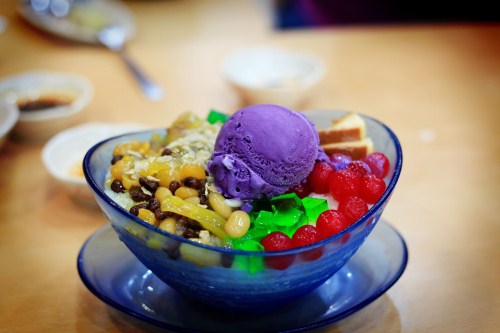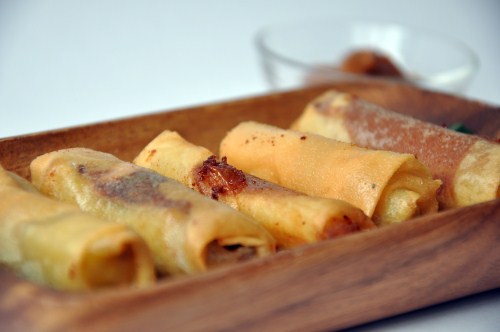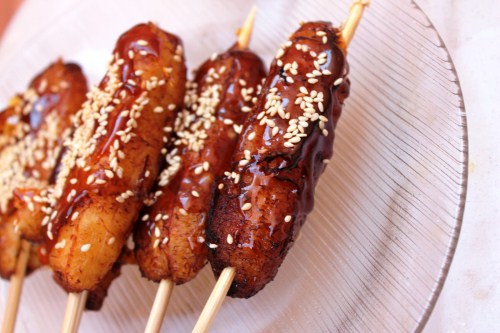Article: Thanh Truc
Champorado – Rich Chocolate Breakfast
Waking up in Ilo Ilo, Philippines, this time I did not choose fast food or some cake in the convenience store but followed my friend, asking around for traditional breakfast stalls on the sidewalk. The rainy season here is the same as in Vietnam, the wind blows, the sky is gray. At times like this, a cup of hot chocolate is the best.
My local friend who was with me suddenly heard me exclaiming, and immediately enthusiastically pulled me into a mobile food cart. Just a moment later, a bowl of Champorado with the fragrant smell of cocoa was served. Despite the rain and wind, many customers who were children continued to drag their mothers in, chattering, but I could only understand the word "Champorado!". The dry and cold rainy season is also the time when children haggle to have Champorado - chocolate porridge - for breakfast every day.

In Pinoy cuisine, people pay great attention to the balance between sour, salty and sweet. Champorado is also prepared according to the principle of balancing flavors. Made from glutinous rice cooked with a special type of chocolate (77% dark bitter), brown sugar and unsweetened condensed milk, Champorado has a very distinctive dark brown color. The interesting thing about chocolate porridge is that it can be eaten hot or cold. Hot is for breakfast, cold is for a snack. Sometimes it is served with dried tuyo fish to balance the sweetness.
This dish is easily available at any Filipino food stall. For those who are short on time, the triple chocolate version of Champorado at Max's Fried Chicken fast food outlets in Manila is also a good choice.
Halo Halo – Come on, let's mix, mix!
Coming to the Philippines without eating Halo Halo is like stepping one foot across the border, not really coming to the country of thousands of islands. Having appeared on famous TV shows and famous newspapers, and even being the subject of the culinary competition Top Chef: Halo Halo, also known as “mixed dessert” is considered the most typical street snack of Filipino cuisine.

A cup of Halo Halo must have a scoop of purple Ube ice cream. Nowhere else do people love purple Ube sweet potatoes like here, almost every dessert, ice cream, and cake has the presence of Ube. Can you guess why purple Ube sweet potatoes are so popular? Simply because the purple color of Ube sweet potatoes is similar to the color of the 100 peso bill of the Philippines. Therefore, this is also the color of luck and wealth. Making Ube Haleyang jam, preparing Ube cakes, eating Ube Halo Halo on New Year's and festivals has become a tradition for many people here.
Back to the famous Halo Halo, under the purple Ube ice cream ball, there is a layer of shaved ice with a few drops of condensed milk, under the shaved ice layer are jackfruit, banana, mango, somewhat similar to the Vietnamese mixed fruit dish. However, Halo Halo also has a layer of tapioca pearls interspersed with beans and jam, some places also add flan. When eating, you have to mix it well, continuously mixing the layers together to have a cool Halo Halo, sweet with the taste of ice cream and fruit.
Banana BBQ Party with Turon, Banana Q, Ginanggang & Maruya
Bananas in the Philippines are very large, almost 3 times larger than Vietnamese Siamese bananas. The banana peel is smooth, greenish-yellow, and the fruit is round. Normally, bananas that are too large will not be fragrant. However, the bananas here, although large, still have a strong aroma. This banana variety is not sweet, with a very light and bland taste. Although it can be eaten raw, most Filipinos reserve this banana for cooking. This is the Saba banana variety, also known as Cardaba banana. Walking through the Philippine market, I was surprised by the variety of banana dishes. The four must-try dishes are Turon, Banana Q, Ginanggang, and Maruya.

Maruya is quite similar to our fried bananas. Roll the bananas into a thin piece, dip them in flour, add a few slices of jackfruit and fry them. The hot fried bananas are usually sprinkled with sugar or poured with a little syrup before being sold. Because Cardaba bananas are not as sweet as Vietnamese bananas, they have a very light taste, so after processing, the banana flavor becomes just right, so you don't have to worry if this dish is too sweet.

Ginanggang attracts attention from afar with its fragrant smell of grilled bananas. In BBQ parties, Ginanggang - BBQ banana is indispensable. Huge Saba bananas are skewered, grilled on charcoal until the outside changes color slightly, then brushed with unsalted butter, continue to grill until light brown, the smell of grilled bananas is fragrant. Finally, roll lightly in a layer of sugar to bring out the banana scent.
With Banana Q or Banana Cue, the banana is peeled, sprinkled with sugar and fried until the sugar melts into a brown caramel layer that permeates the banana. Even more elaborate, instead of making Banana Cue, try rolling it in rice paper, adding a few slices of jackfruit, and frying it. And you have Turon - "banana spring rolls", as I call it. Even those who don't know how to cook can make Turon at home. Cut the banana in half, roll it in brown sugar, add a few slices of jackfruit, or mango, or even a little cheddar cheese if you like, and roll it up in rice paper. Wait for the oil to heat up, dip your chopsticks in to check the temperature, if you see tiny air particles around the chopsticks, put the "banana spring rolls" in, sing your favorite song twice. Then take it out, at this point the sugar has melted into caramel, seeping out of the shell. Let the banana BBQ party begin!
Pastillas de leche – for a tropical tea party
Originating from the classic Spanish dessert Leche Frita, Pastillas de Leche is also a “milk ball” often prepared by mothers and grandmothers during cozy family gatherings. Surely you have not forgotten that fried milk has been extremely popular with sweet tooths since its first appearance in Vietnam, but if you do not like the heavy smell of fried oil, then “milk balls” are absolutely for you.

Carabao milk is often used because it is a type of milk that is rich and creamy. Boil carabao milk, add a little sugar to make the mixture easy to thicken, stir continuously like when making hot chocolate until the mixture thickens. Pour into a mold, or simply let it cool and roll it into balls with your hands, roll it in a layer of granulated sugar or powdered sugar, and you will have plump, chubby "milk capsules". Pastillas de leche are often used in tea parties, and are also a familiar street food in the land of thousands of islands.
Refrigerated “fresh milk balls”, small round or cylindrical in shape, extremely simple, but addictive because of the smooth, cool and sweet milk flavor. This will be a new Christmas gift for your loved ones.
Christmas Morning Flavor - Bibingka
If Christmas in Europe cannot be without Turkey, Christmas in the Philippines will not be complete without the taste of Bibingka in the morning. Originating from China, Bibingka is also a favorite dessert of the Filipinos, the cake is smooth, soft, and not too sweet.
Bibingka is made from rice flour, coconut milk, eggs, sugar, butter, and milk. Sift the rice flour with sugar and quickly pour it into the mixture of eggs, coconut milk, butter, and milk. Shake to mix well, being careful not to beat the mixture until smooth before pouring it into a clay pot lined with banana leaves. This way, the dough will rise a lot. The cake comes out hot, soft, and spongy, you can add salted eggs on top, or grated coconut, some special versions of Bibingka have kesong puti cheese (cheese from carabao buffalo milk), or pineapple.

Bibingka is usually sold in front of churches during Christmas season, so if you come to the Philippines this November and December, you can enjoy many types of Bibingka, especially Bibingka with Balut as a topping. You can also easily find hot Bibingka in flea markets or at bakeries like Frino's Bibingka in Metro Manila.
The cuisine of the country of thousands of islands is the fusion of many cultures such as Spain, China, India. Not to mention that it also has some influences from neighboring countries such as Vietnam, Indonesia, Malaysia... Cuisine is like a window to look into the soul of a country, tasting the dishes in the Philippines, I seem to see the sweetness, warmth and friendliness of the people here.
Enjoy the food at:
Loriekot's Lutong Bahay- 193 Dien Bien Phu, District 3, Ho Chi Minh City
Manila Fiesta- Parkson Le Thanh Ton, 35 Bis 45, Le Thanh Ton, District 1, HCMC


































